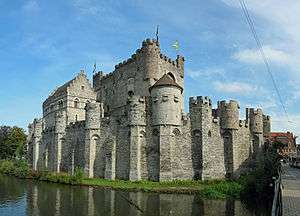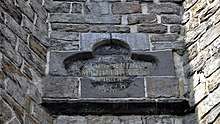Gravensteen
| Gravensteen | |
|---|---|
| Ghent, East Flanders | |
 The Gravensteen, seen from the south-east | |
 Gravensteen | |
| Coordinates | 51°03′26″N 3°43′14″E / 51.057222°N 3.720556°E |
| Type | Castle |
| Site information | |
| Owner | City of Ghent |
| Condition | Restored |
| Site history | |
| Built | 1180 |
| Materials | Sandstone, Tournai limestone |
| Garrison information | |
| Occupants | The Counts of Flanders (1180-1353) |
The Gravensteen (Dutch; literally "Castle of the Counts") is a medieval castle in the Belgian city of Ghent. The current castle dates to 1180 and was the residence of the Counts of Flanders until 1353. It was subsequently re-purposed as a court, prison, mint and even as a cotton factory. It was restored over 1893-1903 and is now a museum and a major landmark in the city.
Origins
The origins of the Gravensteen date to the reign of Arnulf I (890-965).[1] The site, which sat between two branches of the Lys river, was first fortified in around 1000, initially in wood and later in stone. This was soon transformed into a motte-and-bailey castle which burnt down in around 1176.[1]
Castle
The current castle date to 1180 and was built by Philip of Alsace (1143-1191) on the site of the older fortification.[1] It may have been inspired by crusade castles witnessed by Philip on the Second Crusade. As well a protective citadel, the castle was intended to intimidate the burghers of Ghent who often challenged the Counts' authority.
The Gravensteen incorporates a large central donjon, a residence and various smaller buildings. These are surrounded by a fortified, oval-shaped enceinte lined with 24 small échauguettes. It also has a sizeable moat, fed with water from the Lys river. From 1180 until 1353, the Gravensteen was the residence of the Counts of Flanders. The decision to leave was taken by Louis of Male (1330-1384) who transferred the court to the Hof ten Walle.[1]
- External view of the gatehouse
 The dedication stone, dating to 1180
The dedication stone, dating to 1180 View of the south side of the donjon
View of the south side of the donjon
Subsequent history
After ceasing to be the residence of the Counts of Flanders, the castle entered a decline. It was used as a court and prison until the 18th century. From 1353 to 1491 it was the site of Ghent's mint. It was later sold to an industrialist who converted the buildings into a cotton factory and various small buildings were constructed on top of the Medieval remains. At one point it was scheduled for demolition. After gradually buying up the castle, the city of Ghent restored the castle in a romanticising Gothic style between 1893 and 1907.[1] It was the centrepiece of the Ghent World Fair of 1913 and remains open to the public.
 The Gravensteen, depicted in Flandria Illustrata (1641)
The Gravensteen, depicted in Flandria Illustrata (1641)- View of the Gravensteen's gatehouse in 1823, prior to the restoration
See also
References
External links
| Wikimedia Commons has media related to Gravensteen (Ghent). |
- Official website
- Castle of the Counts at Visit Ghent
- Gravensteen at Inventaris Onroerende Erfgoed